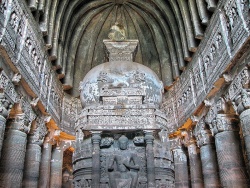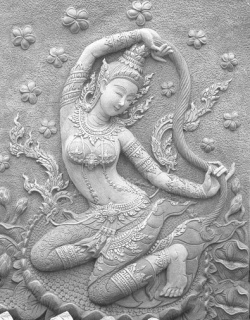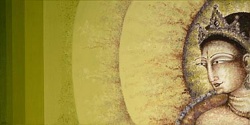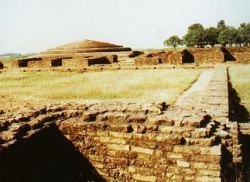Ekavyāvahārika
The Ekavyāvahārika (Sanskrit; traditional Chinese: 一說部; pinyin: Yī Shuō Bù) was one of the early Buddhist schools, and is thought to have separated from the Mahāsāṃghika sect during the reign of Aśoka. Ekavyavaharika in Sanskrit, Ekabyohara in Pali. One of the Hinayana sect, a branch of Mahasanghikah, which considered things as nominal, i.e. just names without any underlying reality. They held that the mind is by its nature pure and radiant, inaccessible to defilement.
Ekavyāvahārika (Sanskrit). A subschool of the Mahāsaṃghika that emerged around the 2nd century bce, also known as the Lokottara-vādins. The name of the school means ‘one utterance’ or ‘one designation’, apparently referring to the notion that the Buddha taught the whole of the Dharma in a single utterance.
History
Relationship to Mahāsāṃghika
Tāranātha viewed the Ekavyāvahārikas, Lokottaravādins, and Gokulikas as being essentially the same. He even viewed Ekavyāvahārika as being a general term for the Mahāsāṃghikas. The Ekavyāvahārikas, Gokulikas, and Lokottaravādins are the three groups that emerged from the first split in the Mahāsāṃghika sect. A.K. Warder notes that the Ekavyāvahārikas were hardly known in later times and may have simply have been considered part of the Mahāsāṃghika.
Early history
The 6th century CE Indian monk Paramārtha wrote that 200 years after the parinirvāṇa of the Buddha, much of the Mahāsāṃghika school moved north of Rājagṛha, and were divided over whether the Mahāyāna teachings should be incorporated formally into their Tripiṭaka. According to this account, they split into three groups based upon the relative manner and degree to which they accepted the authority of these Mahāyāna texts. According to Paramārtha, the Ekavyāvahārikas accepted the Mahāyāna sūtras as the words of the Buddha (buddhavacana).
Doctrines
Forty-eight theses
The Samayabhedoparacanacakra of Vasumitra regards the Ekavyāvahārikas, Gokulikas, and Lokottaravādins as being doctrinally indistinguishable. According to Vasumitra, 48 theses were held in common by these three Mahāsāṃghika sects. Of the 48 special theses attributed by the Samayabhedoparacanacakra to these sects, 20 points concern the supramundane nature of buddhas and bodhisattvas.
Trascendent speech
The name of the Ekavyāvahārikas refers to their doctrine that the Buddha speaks with a single and unified transcendent meaning. They emphasized the transcendence of the Buddha, asserting that he was eternally enlightened and essentially non-physical. Just as the words of the Buddha were held to be spoken with one transcendent meaning, the Four Noble Truths were understood to be perfectly realized with one wisdom.
Fundamentally pure mind
The Ekavyāvahārikas held that sentient beings possessed an originally or fundamentally pure mind, but that it has been encumbered and obscured by suffering. This conception of the nature of the mind as being fundamentally the same as that of the Buddha, has been identified with the Mahāyāna doctrines of Buddha-nature and the Buddha's Dharmakāya, as well as compared favorably with doctrines in Mahāyāna sūtras such as the Lotus Sūtra and the Avataṃsaka Sūtra.
EKABBOHĀRIKA (var. Ekavyohārika, ekabbohāra Skt. Ekavyavahārika Ekottiya).
one of the earliest and short-lived Buddhist sects in India that branched ofl' from the mahāsanghika school (Dhpy. v. 40; Mhv. v. 4; W. W. Rockhill, Life of the Buddha, p. 182; Jiryo Masuda, Origin and Doctrines of Early Indian Buddhist Schools, p. 15). It is short-lived most probably because the differences it had with the other sects of the same school were very insignificant; it could very well have merged with one or the other sect. In fact, Vasumitra in his Nikāyabhedopacaranacakra enumemerates 48 doctrinal points this school held in common with the Mahāsanghikas and the two other branches of the Mahāsanghikas, namely, the Lokottaravāda and the Kaukkutika (Masuda, op. cit. pp. 18 ff.).
The Pali literature is not very helpful in forming a satisfactory view of the doctrine of this school; only the vamsatthappakāsinī. the Mahavamsa commentary has made an attempt at giving an explanation, but even that does not throw any light on the matter. It says that the two sects that arose from the Mahāsanghikas, namely, the Ekabbohārika and the Gokulika misunderstood the passages like "all, monks, is ablaze... All conditioned things are full of misery" (sabbam bhikkhave ādittam...sabbe sankhārā dukkhā) and interpreted them, without making any distinction, to mean that all conditioned things are hot ashes (kukkulo) and are like the hell of ambers (Mhvt, I, 173). See also DPPN s. v. Ekabbohāra.
According to the Nikāyabheda-vibhanga vyākhyāna of Bhavya and the Nikāyabhedopadarśanasangraha of Vinītadeva (Ten-Gyur, Vol. 90), the Ekavyavahārikas were so named because the members of this sect held that all the doctrines are thoroughly understood by a unique and immediate (ekavyavahāra) wisdom, for all the doctrines of the Buddhas are comprehended by the intellect (Rockhill, op. cit. p. 183).
It is, however, Vasumitra who gives a fairly comprehensive account of the doctrine of this sect (Nikāyabhedopacaranacakra, translated from its Chinese and Tibetan versions into English by Jiryo Masuda op. cit. pp. 18 ff.) According to this account, Ekavyavahārikas held 48 views in common with the Mahāsanghikas, the Lokottaravādins and the Kaukkutikas. Vasumitra also gives nine views as the later differentiated views of these four schools; but, of these nine views, he does not mention the particular views held by the divergent sects.
The 48 views they held in common are connected with the nature of the Buddha, the bodhisattva, the arahants and the srotāpannas; mind and mental states (citta and caitasika), dormant passions (anusaya) and their outbursts (paryavasthāna), and the unconditioned (asamskrta).
They held docetic views about the personality of the Buddha and the bodhisattva which later on developed into the Mahāyāna Trikāya doctrine. Concerning the nature of the arahants they upheld the five points of Mahādeva which declared that the arahants are defective, the germ that gave rise to the Mahāyāna bodhisattva ideal, as opposed to the Theravāda arahant ideal. The srotāpannas, according to them, are not excluded from retrogression, and are liable to commit all sinful acts except the five heinous ones (anantarya). These views, which the Ekavyavahārika sect held together with the Mahāsanghika school and its branches, clearly point to the fact that the tendency towards Mahāyāna was very early and they can properly be called the precursors of Mahāyāna.
As far as the mind and mental states are concerned they rejected the view, held by the Theravādins and the Sarvāstivādins, of the existence of indeterminate states (avyakrta-dharma); they accepted only the states which are wholesome (kusala) or unwholesome (akusala). The dormant passions (anusaya) are neither mind (citta-dharma) nor mental (caitasika-dharma); they never become the objects of thought. The dormant passions are different from their outbursts (paryavasthāna) and vice versa. The anusayas do not combine themselves with the citta while paryavasthāna does. This latter view is opposed to the Theravādins and Sarvāstivādins who denied the existence of anusayas apart from paryavasthānas. Regarding the unconditioned (asamskrta-dharma) they advocated nine kinds of it as against the the one in the Theravada and the three in the Sarvastivāda (Masuda. op. cit. pp. 18-32).
These, in brief, are the doctrines they held in common with the other sects of the Mahāsanghika school. The nine points enumerated by Vasumitra as the divergent views that arose later on among the four sets include the doctrines that there are
- things which are caused by the agency of self (svayamkrta)
- things which are caused by the agency of others (parankrta) and
- things which are caused by both (ubhayankrta);
- that two thoughts can arise side by side at one and the same time, etc..
views which are alien to Theravāda."



